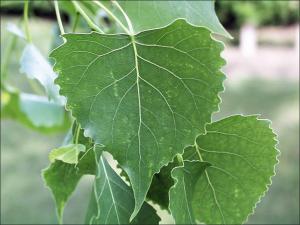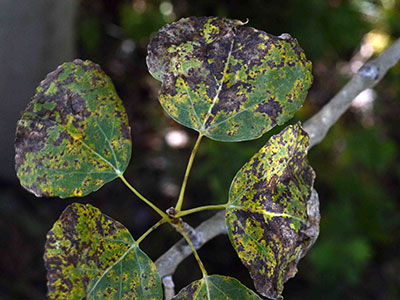cottonwood tree leaf disease
Alba Pests Common diseases include Melampsora leaf rust Septoria leaf spot and canker Cytospora canker wetwood and stem decay. Cottonwood Tree Fluff Can Be a Nuisance to Some People Cottonwood fluff surrounds the seeds of female tree species and may cause allergy One of the unique aspects of cottonwood trees is the white soft fluff that seems to get everywhere.

Fusarium Wilt Enivornmental Issues And Disease Often Cause Similar Symptoms For Example Yellowing Of Leaves Could Be Fr Plant Diseases Plants Annual Plants
The larvae burrow into the phloem which can severely damage young or stressed trees.

. Dothichiza or Branch Canker. Leaves drop. One key to diagnosis is that you will find the fungal growth on both the upper and lower surfaces of the affected leaves.
The symptoms start as yellow-green or light green spots in late spring-early summer with added tar-like formations by the late summer. Dark sunken cracked cankers form on twigs trunks and branches. However Cytospora spp.
Its a fungus-based disease that affects stressed trees which would include cottonwoods that experienced a late frost. This tree leaves disease is usually caused by the Rhytisma fungi colonizing the maple family maple proper and sycamore. Huge host range.
Tremuloides White Poplar P. Leaf spots and blotches appear in the spring later for walnut often following leaf veins. Female and juvenile scales do not have wings legs.
Cottonwood tree leaf disease - Knowledgebase Question. This tree leaves disease is usually caused by the Rhytisma fungi colonizing the maple family maple proper and sycamore. The beetle can completely defoliate a cottonwood tree.
Cottonless cottonwood trees may be attacked by tiny sap-sucking aphids soft and armored scale insects and mealybugs. Quick facts Leaf spot diseases weaken trees and shrubs by interrupting photosynthesis. It is caused by a bacterial infection that enters through wounds in the.
Numerous disease organisms attack cottonwood. When laying eggs and feeding gall-forming insects secrete chemicals that mimic the. Close examination reveals small yellow-orange bumps filled with powdery spores on the leaves.
Scale insects are not always recognizable as insects. Cottonwood is indeed susceptible to powdery mildew. Fusarium solani enters wounds particularly after major floods to cause a canker.
Cankers first appear as slightly sunken areas on the smooth bark of branches and trunks. Insects and disease organisms are a continuing threat to cottonwood Populus deltoides Bartr especially during the trees first 5 years. Worse in years with wet springs.
Opportunistic fungus attacks weak stressed. Leaf spot diseases may become epidemic during a wet spring and summer. I just noticed that the leaves not all are curling under.
Trees - Freeze damage sunburn drought low fertility physical injuries etc. It is also susceptible to aphids scales thrips anthracnose crown rot mistletoe and sooty mold. Leaf Beetles The cottonwood leaf beetle is 14-inch long.
The danger is intensified in large plantings of a single species and age because rapid buildup of damaging agents can occur. Canker in cottonwoods can be easily identified by its sunken discolored areas of bark. Slime flux is also called wetwood.
Cytospora chrysosperma causes a canker where sites are adverse and tree vigor is low. Fungal disease caused by. What is it and what can I do to prevent further occurence.
My cottonwood is 2 years old and growing quite well. A common Cottonwood and Poplar tree disease is Cytospora Canker. Rusts are fungal diseases that affect leaves of several hardwood species.
Although the unsightly leaves and excessive leaf fall can be spectacular they usually cause only minimal growth loss. Leaf rust is a common problem but rarely is serious. Most leaf spot diseases affect only a small percentage of the trees overall leaf area and are a minor stress on the.
If not treated the tree dies from girdling. Galls are lumpy growths caused either by insects or bacterial pathogens. Theres also a tree disease called Canker cytospora canker that affects members of the poplar tree genus including cottonwoods.
Cottonwood and other poplars willows fruit trees elm conifers spruce pecan. Plant Disease Clinic many other broadleaf trees. However its marssonina leaf spot cytospora canker and slime flux that are the most serious problems.
The cottonwood tree is a hardwood tree that loses its leaves in the fall. Leaf spot diseases should be taken seriously if they result in moderate to complete leaf. Lanceleaf cottonwood can suffer from borers and canker disease.
Anthracnose Control high risk of spreading the fungal pathogen Identification On sycamore ash maple oak and walnut. Several fungi cause leaf diseases on cottonwood throughout its geographic range. All of these pests have piercing sucking mouthparts that allow them to.
Pest Diseases to Watch For As with other poplars narrowleaf cottonwood is susceptible to aphids beetle borers scales thrips anthracnose canker crown rot mistletoe and sooty mold. I think there is a bug on it. Callus tissue may form.
Are fairly host specific. Signs of an infestation include shoots that turn black shrivel and then die. Question by wycjce July 28 2005.
The fungus attacks weakened trees affected by drought late-spring frosts insect and fungi defoliation or trunk and root injury. Cottonwood and Poplar Populus spp. Septoria musiva causes a small canker that opens a path for other canker organisms.
Here is a link to the Texas Plant Disease Handbo0k information about cottonwood diseases. There are a number of borers which are attack cottonwood and elm. The danger is intensified in large plantings of a single species and age because rapid buildup of damaging agents can occur.
However cytospora canker is the biggest invasive threat to cottonwood trees partially because the wood is already weaker than other types of trees. It is characterized by yellow spots on the upper leaf surface. The fungus spreads across the living bark and wood of the tree.
Cottonwood Tree Diseases Insect Infestations Slime Flux. The trees are notorious for fluffy strings of seeds that get carried great distances in the breeze. Deltoides Quaking Aspen P.

Plant Trees For Great Fall Colors Grimm S Gardens Trees To Plant Fall Colors Autumn Garden

Dutch Elm Disease And American Elm Trees Dutch Elm Disease Elm Tree Tree

Featured Diagnosis Crown Gall Agrobacterium Tumefaciens Plant Diseases Plants Crown

On The Trail Cottonwood Tree Sibley Nature Center

15 Trees You Should Never Grow In Your Yard Poplar Tree Landscaping Lombardy Poplar Poplar Tree

Eastern Cottonwood Natural Resource Stewardship

Kansas State Tree Cottonwood Cottonwood Cottonwood Leaf Trees To Plant

Poplar Tree Diseases Poplar Tree Tree Poplar

Aspen Leaf Plant Leaves Leaves

Field Guide Manual On The Identification And Management Of Poplar Pests And Diseases In The Area Of The Three North 009 Project North Eastern China

Melampsora Rust Also Known As Poplar Leaf Rust Is A Foliar Rust Disease That Has Been A Large Problem For Trees In The Gen Aspen Trees Poplar Tree Cottonwood

Tree Time Tree Search Tree Identification Texas Trees Tree Leaf Identification

Aspen Cottonwood Leaf Diseases Not Lethal To Trees But Could Impact Fall Colors Colorado State Forest Service

Cottonwood W Seed Pods Tree Identification Landscaping Plants Wild Plants

Field Guide Manual On The Identification And Management Of Poplar Pests And Diseases In The Area Of The Three North 009 Project North Eastern China

Hybrid Poplar Tree Hybrid Poplar Tree Shade Trees Fast Growing Shade Trees

Examples Of Exaggerated Leaf Growth Due To Various Forms Of Plant Download Scientific Diagram

Inspiration Of Time And Trees Streams Poured Out Tree Plant Leaves Horse Trough
